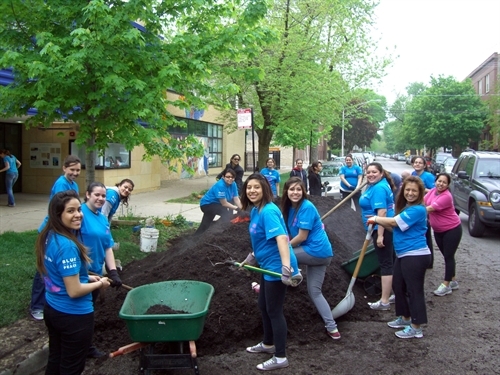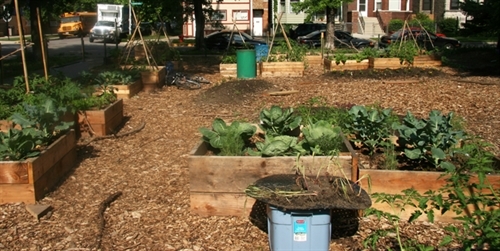
All photos courtesy of cornerfarm.org
Student learns to harvest cilantro.
During its first year in operation, Logan Square’s Corner Farm was really good at growing basil. Four years later, what started as an effort to bring public art and more green space to the community is now a thriving vegetable farm run by volunteers who donate all of their harvest, about 10-15 lbs per week, to local families in need.
With a friendly neighbor who wanted to see his empty corner lot at the intersection of Altgeld and Sawyer avenues put to productive use, volunteers built boxes, added soil and planted seeds to get the garden up and running. It didn’t take much to pique the interest of passersby and convince them to stop and lend a hand. Although Logan Square is well-known for its tree-lined Logan Boulevard, the City of Chicago has identified the neighborhood as one of the “most densely developed areas […] with the least amount of open space per capita of any Chicago community area except South Lawndale.” So it wasn’t surprising that as the team started building the garden, people started to come.
The Corner Farm is located along a major foot-traffic thoroughfare – a route that many commuters take on their way to the Logan Square Blue Line station. As the team started to build the garden, people walked by and offered to lend a hand. That was four years ago. Today, a robust network of volunteers cares for the space and grows a range of crops from tomatoes to kale to herbs. Formerly novices at growing plants, a few of the volunteer farmers are soon-to-be certified master gardeners. And thanks to all the love and support from the community, the Corner Farm recently expanded, adding a second location, Kimball Medill, at the intersection of Kimball and Medill avenues.

Community volunteers help move a mountain of soil into the beds.
Community gardens and urban farming have rapidly gained popularity across Chicago in the last five years or so. Gardens are established for many reasons, ranging from a general lack of green space, to providing fresh produce to communities that otherwise lack access to it. Almost every garden is planted in a vacant lot – transforming a liability into a community asset. In general, community gardens provide growers an opportunity to connect with each other, their food, and their environment. So what makes one garden stand out from the others? The Corner Farm follows a communal tending model, which means that volunteers take on farming the lot, but unlike most other models in the City, Corner Farm donates all of its produce to the food pantry located across the street at Christopher House, a local non-profit dedicated to helping at-risk youth and their families. Partnering with a teacher at Christopher House, students participating in summer programs learn about growing their own food and volunteer at the garden at least once a week. To deepen the relationship between these neighbors, parents are also invited to participate in the tending of the farm.

Corner farm's first growing season.
Many of these students’ families also receive food donations from Christopher House, so they get to bring home and eat some of the food they grow. Since families sometimes find themselves with vegetables that they just don’t know what to do with, volunteers are working with families to identify crops that are more appealing. They are also asking local restaurants for recipe donations that answer the question, “so what am I actually supposed to do with this [insert mysterious vegetable name here]?” As farming evolves this year, the team will quantify their harvest to have a better idea of how much food they actually donate.

Students show off their harvest.
Brie Callahan and Margaret Hartmann lead the efforts at Corner Farm. Both were initially drawn to the garden to spend more time outdoors, but feel that the connection to the community is what keeps them coming back each year. Having an outdoor space to grow vegetables adds a lot to the neighborhood, but Callahan explains that it’s about more than that. “As I still love the gardening aspect, it's really the community-building that keeps me coming back each season. I can grow tomatoes in my backyard, but I can't grow a neighborhood.” Community gardening has helped volunteers connect with neighbors they otherwise may never have met. “I feel connected to Logan Square now in a way that I've never experienced in my 30+ years living in Chicago.”
This project exemplifies Placemaking Principle #9 – Start with the petunias (or basil). Once the farmers learned that they could harvest significant amounts of produce on a regular basis, they decided to donate their entire crop to Christopher House. The new Kimball Medill farm follows a slightly different model, allowing volunteers to tend a bed for themselves while also maintaining a bed whose harvest will be donated, known as a grow-one give-one model. This allows volunteers to enjoy the fruits of their labor –the edible kind, and the feeling they get by connecting to their neighbors. The farms grow vegetables, sure, but more compellingly, they foster a sense of community. Like all great placemaking stories, Corner Farm Chicago isn’t about the farm; it’s about the people.